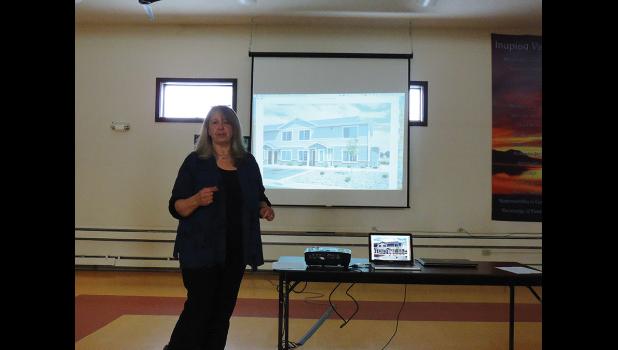Affordable housing project introduced at NEC meeting
On Friday, a few dozen people gathered in Trigg Hall at the Nome Eskimo Community building to discuss a proposed low-income housing project. The project would involve the possible use of City Block 35, located between East Third and First Avenues, and East L and M Streets, the empty lot behind the old Country Store.
Sue Steinacher of NEST housing and Glen Pardy of NEC housing led the meeting, introducing the project’s background, lot information, developer information and how the low-income housing project would be funded.
Several members of the public attended the meeting, both voicing their opposition to the location of the proposed housing complex and congratulating Steinacher and NEC on their efforts to bring more housing options to Nome. While everyone in the audience seemed to agree that more affordable housing is needed in the community, there were differing opinions on location, housing regulations, income requirements and the future management of the complex.
Steinacher explained that the project comes from a cumulation of years of research on how to find funding for low-income housing options in the area. While there are many federal low-income housing voucher options in the state of Alaska, Nome is just too small of an area to qualify for many of these programs.
According to Steinacher, the Alaska Housing Finance Corporation, AHFC for short, in Nome currently has around 50 families on their wait list, while the Bering Straits Regional Housing Authority, or BSRHA, has seven families on their list. The lack of housing causes overcrowding in local homes, with many families having to live in cramped quarters. To address this concern, Steinacher set out to find funding opportunities available for this area.
The housing project would be funded by a low-income housing tax credit and the AHFC. Nome Eskimo Community would donate the land for the project (proposed as City Block 35) as the main sponsor, and BSRHA would manage the property. The NEC Tribal Council will be meeting in the near future to discuss the project’s feasibility and to determine if the proposed lot should be used. If the tribal council approves the project, NEC will compete with other proposals around the state to gain access to these limited funds.
The low-income housing tax credit program is an IRS program that was developed in 1986. The program works by offering large banks or corporations a tax credit in exchange for funding low-income housing developments. The program would cover all the construction costs – estimated at about $9 million to build on City Block 35 – while the rent collected from tenants would cover maintenance and operations.
Unlike other low-income housing complexes in the area, this new complex is proposed to include an on-site manager. The grounds of the complex and maintenance would be managed by BSRHA. The housing complex would have 14 “family-friendly” units, including parking areas and possible storage units. There would be extra space to be used as either a playground or open green space, depending on public input.
During the informal meeting, public discussion was heard throughout. Several members of the community who live near City Block 35 spoke out in concern of more rentals being built in the neighborhood. Neighbors complained about junk in yards, dog feces and cigarette butts that have accumulated in the past at other rental properties.
Other members of the public were concerned that providing more low-income housing would only add a small amount of housing to the community – the concern was that once people get into the low-income system and have an affordable rent, they tend to never leave. There was much discussion on the rental agreements, regulations and low-income qualifications.
Steinacher attempted to assure the concerned public that this would be a well-managed, attractive building with strict regulations, but also comply with the fair housing act. Having an on-site manager would be one way to ensure that rules are followed. “It’s going to be the nicest housing in Nome, and the newest housing in Nome,” said Steinacher.
Some people spoke out in favor of more affordable, single-family homes being built as opposed to a large rental complex. Other areas of the city were also suggested for the project, such as the open undeveloped area on East Sixth Avenue. While this option has already been explored, Steinacher and Glen Pardy both pointed out that it would add more cost to the project for developing electrical and water access to that area, as well as making it a less attractive proposal.
In order to qualify for the low-income housing tax credit program, the land used must be donated. Since Nome Eskimo Community bought City Block 35 in 2004 using a Native American housing grant, with the stipulation that if developed, it must be used for future affordable housing, this has remained the most attractive solution.
During the meeting, the co-owner and development consultant for Blue Line Development, Nate Richmond, was on the phone to be able to take questions. If the project proposal succeeds, Blue Line Development of Montana would complete the construction of the complex. Richmond assured the public that the complex would be built to cold climate standards, and that it would be visually pleasing and functional. Richmond also expected the project to create several local jobs during the construction phase.
If given the go-ahead by the NEC Tribal Council, the proposal will still need to be approved and the funds granted. The location of the project could still change. The final application is due by July. If approved, construction could begin as soon at summer 2018 and be completed by summer or fall 2019.

